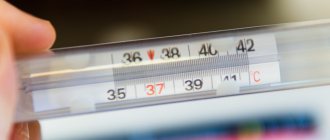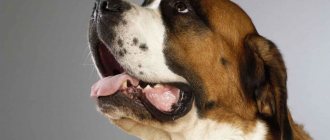The human and animal body is a coherent system in which the work of each organ is important. The heart provides blood flow, sensitively responding to the slightest changes in health status. By the nature of a dog’s pulse, one can determine the quality of its heart function, and, therefore, the vitality of the body. A change in heart rate compared to normal values may be a natural reaction of the body, or may indicate the presence of serious diseases. How to measure a dog's pulse? What should be the normal heart rate for individuals of different ages and sizes? Read about it in our article.
Standard heart rate indicators for dogs
The rhythm of the pulse is determined by the vibrations of the walls of large arteries that appear during contraction of the heart muscle. Using this indicator, you can assess the health status of your four-legged pet. Failures can be the result of heart disease, serious poisoning, disturbances in the functioning of internal organs, or hypothermia. It is periodically necessary to check the pulse for preventive purposes in order to identify possible problems in time.
The normal pulse rate in dogs varies over a wide range. The norm may be a rhythm of 70 to 180 beats per minute. This variation is explained by the dependence of the indicators on the size and age of the pet. For small dogs, such as a Chihuahua or a pug, the norm may be a pulse of 150 to 180 beats, for medium-sized pets it is 120-140, and for representatives of large breeds, for example, a St. Bernard, a pulse of about 100 is considered normal.
This indicator is also influenced by age. In an older dog, all processes naturally slow down, including the speed of blood flow. Their heart rate will not be as high as that of a puppy or young animal. There may also be individual deviations. In order to determine the norm for a particular dog, you need to measure the pulse of a healthy dog in a calm state for several days and calculate the average result.
Briefly about the main thing
- Pulse is an important indicator of proper heart function;
- The “norm” of its indicators is not the same for all animals and depends on age, weight, size and physical condition;
- There are pathological and physiological changes;
- The owner should take periodic measurements and keep a log;
- Pathological changes indicate congenital diseases of the heart muscle or the presence of a disease;
- Treatment of the animal is carried out under the supervision of a veterinarian, after appropriate research and analysis.
Do you take periodic measurements of your pet? Can you do this? What abnormalities were identified and how was the treatment? Share your experience in the comments to the article, it will help our other readers.
Did you like the article? Share it with your friends on social media. networks. This will help them get useful information and support our project.
Causes of increased heart rate
An increased heart rate is not always a consequence of the presence of a disease. Tachycardia will be observed after active games and jogging. The rhythm accelerates if the dog is frightened by something or is in a state of stress. If there are no natural causes for tachycardia, and an increase in heart rate is observed regularly, this may be a consequence of:
- diseases of the cardiovascular system;
- malignant tumors in the respiratory system;
- inflammatory processes;
- disruptions in the functioning of the endocrine system.
Increased heart rate is observed in coronary artery disease, arterial hypertension, and myocardial infarction. This disorder can appear during endometritis, pneumonia, and inflammation in the heart tissues. It is one of the symptoms of diabetes and hyperthyroidism. With regular tachycardia, it is necessary to have the dog examined at a veterinary hospital.
Circulatory support
During cardiopulmonary resuscitation, blood circulation is maintained by rhythmic chest compressions, also known as chest compressions. Animals with obvious chest injuries should not undergo chest compressions.
Your goal is to ensure sufficient blood flow to the heart and brain to support their activity. The choice of massage technique depends on the number of people providing assistance and the size of the animal.
Maintenance of blood circulation should be combined with artificial respiration: • when providing assistance alone, two consecutive breaths should be alternated with five compressions on the chest • if resuscitation is carried out by two people, one person performs only artificial respiration (15-20 breaths per minute). The second performs chest massage as described below:
Small dogs (100 compressions per minute): • one or both palms clasp the chest from below or above, while the animal should lie on its side • the chest is compressed in the center, not necessarily over the heart • concentrate pressure on one point. Rough pressure can break ribs. Be careful not to compress your chest too much due to anxiety.
Medium to large dogs (100 compressions per minute): • Place the animal on its side and stand behind its back. During the massage, you can press the animal with your leg or thigh to ensure its immobility • straighten your arms, clasp the fingers of both palms and place your palms on the chest. Remember, pressing on the chest near the heart is not as effective as squeezing the chest where it is widest; • start the massage at a rate of 100 compressions per minute; • do not squeeze the cell more than half its volume. Ribs can be broken!
Basic resuscitation techniques should be performed on the way to the veterinary clinic, because further special resuscitation measures and supportive treatment will be required, which are possible only in a clinic setting.
It should be understood that even in cases where resuscitation is carried out on time and correctly, it happens that its techniques are not enough to maintain brain life and prevent death, even if it is possible to restore cardiac and respiratory activity.
Signs of tachycardia
It is not always possible to regularly check your dog's heart rate. There are certain signs indicating the presence of malfunctions in the functioning of the organ. In a pet with a rapid heart rate:
- there is general weakness, reluctance to move actively;
- mucous membranes turn pale;
- appetite decreases;
- shortness of breath appears during exertion;
- a noise is heard when breathing, the mouth is open;
- cough appears;
- The temperature periodically rises to 39°C.
The dog examination program to identify the causes of tachycardia includes: blood and urine tests, electrocardiogram, ultrasound of the abdominal cavity, sternum, and radiography.
Clinical death
The basis for performing cardiopulmonary resuscitation is the presence of obvious signs of clinical death (the so-called visible cessation of vital body functions).
The onset of clinical death is determined by one or more of the following signs: • Complete cessation of breathing • Heartbeats and pulse undetectable by palpation • Mucous membranes remain blue • Persistent loss of consciousness
There are situations when the animal’s breathing, heartbeat and pulse are present, but the patient is unconscious. If you try to perform cardiopulmonary resuscitation on him, and at that moment the animal suddenly regains consciousness, you risk serious bites!
Causes of bradycardia
A slow heart rate is medically called bradycardia. Heart rate decreases when:
- severe poisoning with lead, nicotine, pesticides, and other toxic substances;
- ischemia, cardiac atherosclerosis, myocarditis, arterial hypotension;
- prolonged fasting;
- hypothermia;
- viral hepatitis, other infections;
- internal bleeding caused by cirrhosis of the liver, malignant tumors, ulcers in the digestive organs resulting from injuries;
- increased intracranial pressure due to meningitis, stroke, traumatic brain injury, bruise.
The rhythm may slow down if the dose of cardiac medications is not taken.
Symptoms that appear with a decreased rhythm should cause concern for the animal owner. It is necessary to urgently contact a veterinarian if convulsions are periodically observed, the dog gets tired quickly, even without exercise, and its paws become tangled while walking. After a full examination, ECG and ultrasound of the heart, the doctor will determine the cause of the disturbances in heart rhythm and prescribe effective treatment.
Respiratory arrest/cardiac arrest
Primary resuscitation measures should be started when the animal is unconscious. Artificial respiration is the most important technique for maintaining life, since the most common cause of death in animals is respiratory arrest.
Artificial respiration: • make sure that the animal's airways are clear; • Squeeze the dog's mouth with one hand to prevent air leakage during forced inhalation. With your other hand, lightly squeeze both sides of the trachea to prevent air from entering the stomach instead of the lungs; • carefully blow air into the animal’s nostrils (for 1-1.5 seconds at a time); • the smaller the dog, the less force the air should be blown into; • artificial respiration should be performed at a rate of 15-20 breaths per minute.
Determining a dog's pulse
The procedure for measuring the pulse will not create problems if the house has a special veterinary automatic device that detects pressure and heart rate. But not all owners of four-legged pets have such blood pressure monitors. In this case, you can measure your pulse using a watch with a second hand.
In humans, this indicator is most easily determined by pressing on a blood vessel in the wrist area. There is a good place to measure the pulse of dogs. A large artery runs through the inner thigh, which will help to accurately determine the indicator. To do this you need:
- lay the dog on its back or side;
- place your finger on the artery, press lightly until you feel shock;
- note the time, count the number of shocks.
If the dog behaves calmly during the procedure, the number of blows over the course of a minute is counted. This allows you to get a more accurate result. But such a procedure will not be possible with a restless pet. Consequently, its time will have to be reduced. You need to count the number of blows within 15 seconds, multiply the result by 4, you will get the desired result. You should not measure your pulse after walking or active games. It will definitely be overestimated, which means it will not be possible to find out about the presence of violations.
Categories of severity of general condition
In emergency situations, there is a so-called triage of patients based on the severity of their condition. Category 1: the animal’s condition is critical; survival is possible provided immediate life-saving measures are taken; Category 2: the patient is likely to survive if help is provided within a few hours; Category 3: the injuries are minor; the patient does not need emergency assistance and may cede the right to priority care to patients in more serious condition.
Magnitude, tension and content
High intensity of the pulse wave is easy to determine - the more difficult it is to squeeze the artery with your fingers until blood circulation through it stops, the higher the intensity.
The filling of the pulse is the amount of blood transferred in one impulse. The weaker the push, the less blood is driven.
The value is a criterion that combines the indicators of the previous two points. The higher the reading, the greater the value, which indicates heart valve insufficiency.
But if the value is large after physical exertion, then this is the norm, and this factor does not indicate illness.
Tracheal collapse
Collapse of the trachea (windpipe) is a common disease characteristic of older dogs of small and toy breeds (Pomeranian, poodle, Yorkshire terrier, Maltese).
With age, the soft tissues of the windpipe lose their elasticity, as a result of which the walls of the trachea collapse, and hence the narrowing of its lumen during the inhalation stage.
Most cases of tracheal collapse occur in obese dogs. Subcutaneous fat deposits in the throat and neck area aggravate the problem. When the trachea collapses, attacks of a loud, dry cough, reminiscent of a “goose cry,” are observed. Difficulty breathing usually leads to an increase in body temperature.
First aid for tracheal collapse: • Wet the dog's chest and abdomen with cool or cold water; • Minimize exposure to stressors. • Take the animal to a veterinarian as soon as possible.
Diseases of the upper respiratory tract, larynx, trachea
Symptoms of diseases of the upper respiratory tract, larynx and trachea differ from diseases of other parts of the respiratory system due to noisy breathing. Mainly while inhaling.
During inhalation, the muscles of the chest and abdomen in such patients work hard to draw air into the lungs. When expanding, the chest noticeably increases in volume, and the walls of the abdominal cavity “fall inward.”
While inhaling, the dog may open its mouth and experience obvious difficulty breathing. The animal looks restless. There may be an increase in temperature as a result of impaired thermoregulation. An increase in temperature, in turn, worsens shortness of breath. Gums are pale, white or bluish. Foreign body in the upper respiratory tract, pharynx or trachea.
Dogs love to play with foreign objects that are convenient to hold in their mouths. During play, such an object can slip into the throat and block its lumen. This condition is life-threatening. Emergency assistance required.
If a foreign body is visible in the lumen of the pharynx: • do not try to remove the object with your fingers; • It is necessary to apply the Heimlich maneuver: If the dog is conscious: from the side of the animal’s back, put your arms around its waist. Make a fist with one hand and place your thumb on your stomach, in the middle, just above your navel. With your other hand, clasp your fist tightly with your hand. Next, with sharp jerking movements of both hands, you need to press on the abdominal area several times in a row. If the technique is effective and the foreign body has advanced into the oral cavity, you will hear a deep breath and a convulsive cough.
• please note that the Heimlich maneuver should only be used when the foreign body is visible; • the use of this method in case of other causes of difficulty breathing may harm the animal; • incorrect execution can harm the dog; • after removing a foreign body using this method, you must show the animal to a doctor. • If the efforts do not lead to success, the animal loses consciousness, the mucous membranes begin to turn blue, it is necessary to immediately turn the animal over a bent knee, head down on its stomach, and hit the interscapular area with the palm of the hand several times. If a foreign object then moves into the oral cavity, remove it (provided you can see it!) • While providing assistance, you must call a veterinarian or go to a veterinary clinic.











